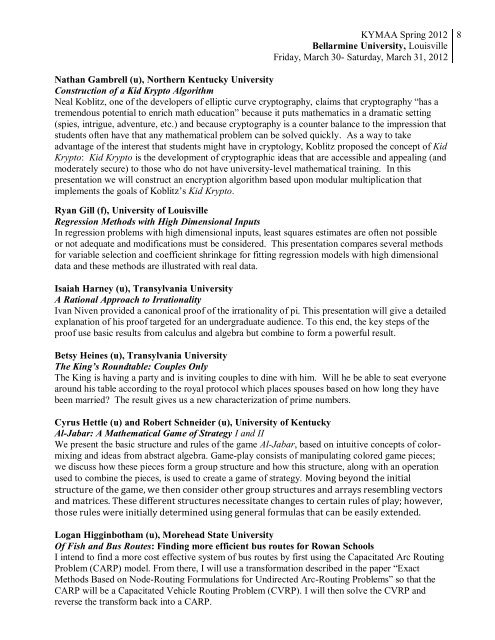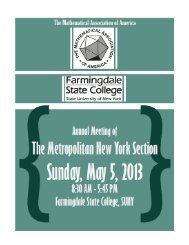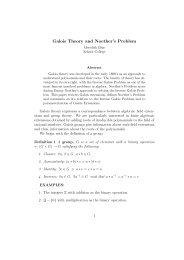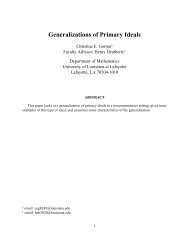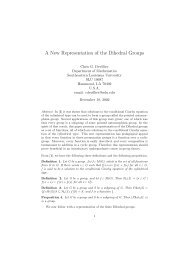Abstracts and Biographical Information - Sections - Mathematical ...
Abstracts and Biographical Information - Sections - Mathematical ...
Abstracts and Biographical Information - Sections - Mathematical ...
You also want an ePaper? Increase the reach of your titles
YUMPU automatically turns print PDFs into web optimized ePapers that Google loves.
KYMAA Spring 2012<br />
Bellarmine University, Louisville<br />
Friday, March 30- Saturday, March 31, 2012<br />
Nathan Gambrell (u), Northern Kentucky University<br />
Construction of a Kid Krypto Algorithm<br />
Neal Koblitz, one of the developers of elliptic curve cryptography, claims that cryptography “has a<br />
tremendous potential to enrich math education” because it puts mathematics in a dramatic setting<br />
(spies, intrigue, adventure, etc.) <strong>and</strong> because cryptography is a counter balance to the impression that<br />
students often have that any mathematical problem can be solved quickly. As a way to take<br />
advantage of the interest that students might have in cryptology, Koblitz proposed the concept of Kid<br />
Krypto: Kid Krypto is the development of cryptographic ideas that are accessible <strong>and</strong> appealing (<strong>and</strong><br />
moderately secure) to those who do not have university-level mathematical training. In this<br />
presentation we will construct an encryption algorithm based upon modular multiplication that<br />
implements the goals of Koblitz‟s Kid Krypto.<br />
Ryan Gill (f), University of Louisville<br />
Regression Methods with High Dimensional Inputs<br />
In regression problems with high dimensional inputs, least squares estimates are often not possible<br />
or not adequate <strong>and</strong> modifications must be considered. This presentation compares several methods<br />
for variable selection <strong>and</strong> coefficient shrinkage for fitting regression models with high dimensional<br />
data <strong>and</strong> these methods are illustrated with real data.<br />
Isaiah Harney (u), Transylvania University<br />
A Rational Approach to Irrationality<br />
Ivan Niven provided a canonical proof of the irrationality of pi. This presentation will give a detailed<br />
explanation of his proof targeted for an undergraduate audience. To this end, the key steps of the<br />
proof use basic results from calculus <strong>and</strong> algebra but combine to form a powerful result.<br />
Betsy Heines (u), Transylvania University<br />
The King’s Roundtable: Couples Only<br />
The King is having a party <strong>and</strong> is inviting couples to dine with him. Will he be able to seat everyone<br />
around his table according to the royal protocol which places spouses based on how long they have<br />
been married? The result gives us a new characterization of prime numbers.<br />
Cyrus Hettle (u) <strong>and</strong> Robert Schneider (u), University of Kentucky<br />
Al-Jabar: A <strong>Mathematical</strong> Game of Strategy I <strong>and</strong> II<br />
We present the basic structure <strong>and</strong> rules of the game Al-Jabar, based on intuitive concepts of colormixing<br />
<strong>and</strong> ideas from abstract algebra. Game-play consists of manipulating colored game pieces;<br />
we discuss how these pieces form a group structure <strong>and</strong> how this structure, along with an operation<br />
used to combine the pieces, is used to create a game of strategy. Moving beyond the initial<br />
structure of the game, we then consider other group structures <strong>and</strong> arrays resembling vectors<br />
<strong>and</strong> matrices. These different structures necessitate changes to certain rules of play; however,<br />
those rules were initially determined using general formulas that can be easily extended.<br />
Logan Higginbotham (u), Morehead State University<br />
Of Fish <strong>and</strong> Bus Routes: Finding more efficient bus routes for Rowan Schools<br />
I intend to find a more cost effective system of bus routes by first using the Capacitated Arc Routing<br />
Problem (CARP) model. From there, I will use a transformation described in the paper “Exact<br />
Methods Based on Node-Routing Formulations for Undirected Arc-Routing Problems” so that the<br />
CARP will be a Capacitated Vehicle Routing Problem (CVRP). I will then solve the CVRP <strong>and</strong><br />
reverse the transform back into a CARP.<br />
8


